Menu
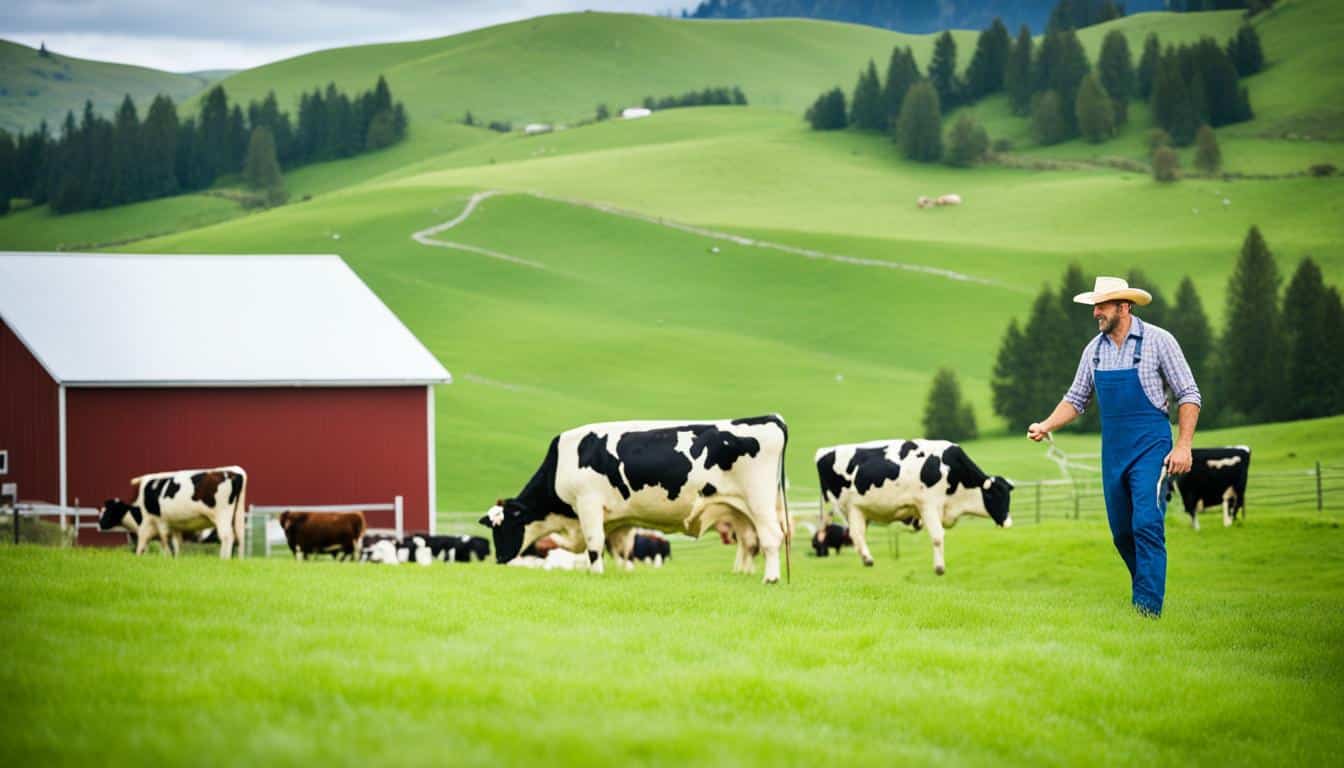
Did you know organic ruminant livestock must have 120 days on certified organic pastures? This is a key part of the organic livestock farming movement. It shows our deep commitment to both ethical treatment and sustainable practices. By meeting these high standards, we ensure the animals’ well-being and support eco-friendly farming.
Organic farming for livestock takes a holistic approach. It starts at a specific point in their life, such as the last third of gestation. Animals get to go outside daily, except in bad weather, and eat only certified organic food. This way, we considerably lower their stress and the risk of diseases. This leads to producing meat in a more caring and eco-friendly way.
Organic livestock farming is based on ethical and sustainable guidelines. It aims to protect our nature, keep animals healthy through natural means, and save wildlife. It avoids using GMOs and non-organic materials to reflect its core values.
It involves strict organic certification standards set by major bodies like the USDA. For instance, all feed must be organic. Ruminant animals must graze on organic pasture at least 120 days a year. These rules help animals act naturally, lowers stress, and boosts their health.
Organic livestock farming is crucial for better health and a cleaner planet. It makes animals healthier by focusing on their diets. This, in turn, makes dairy and meat better for us. Adding different plants to pastures helps the environment too. It boosts soil health and supports a variety of plants and animals.
This type of farming is kind to animals and fights climate change. It emits fewer greenhouse gases than regular farming. Also, it can actually pull carbon out of the air, helping our planet stay cool. In the end, organic farming provides us with top-quality food while looking out for nature and our animals.
To get USDA Organic Certification for livestock, you must really know and follow the USDA organic regulations. This certification aims to keep animal health and welfare standards high. For ruminant livestock, 30% of their diet must be from organic pasture. They need to graze for at least 120 days. Depending on where they are, this grazing season could be longer, even up to 365 days a year.
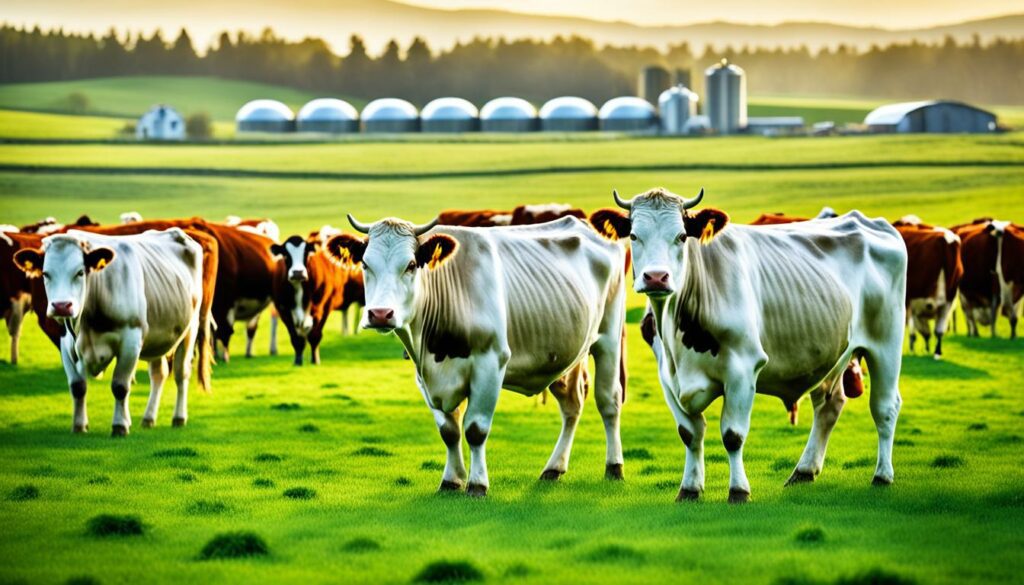
Organic livestock must live naturally, meaning they have time outside, a clean home, and eat organic food. This means no antibiotics, growth hormones, or certain other harmful things. The aim is to keep the animals happy and healthy, which lowers sickness and makes them thrive.
Becoming certified involves a lot of paperwork and farm checks by experts. Farmers need to keep records about how they look after their animals organically. They must follow strict rules. They should mainly use natural ways to prevent and treat diseases. If any animal does need medicine that’s not allowed in organic farming, it can’t be sold as organic later. This shows the serious dedication to looking after animals well and making sure all organic foods are top-notch.
Sticking to sustainable practices in animal farming is key for moral reasons. By using pasture systems, we help animal health and save the earth. Let’s explore the top ways for farming in pastures without harming nature.
Making sure pastures are managed well is crucial for the health of animals. It also ensures they fulfill the rules. Giving animals space to roam is important. It lets them eat grass and herbs from the land, improving the quality of their milk and meat.
Products from animals that get to graze have more of the good stuff we need. For instance:
Maintaining pastures well is a must. It means chickens that roam freely are healthier for us. This shows why it’s good to stick to high standards for the land animals graze on.
Looking after soil, water, and other resources is necessary for how we farm animals. Proper handling of waste and planting cover crops can protect these. Things like changing what we grow each year can keep the soil rich and unspoiled, making a long-lasting home for plants and creatures.
Sustainability links farming to positive effects on the planet. For example, in areas like the Sahel, better pasture care has improved a vast area. This supports economies, especially those run by women.
Techniques that save soil and water also cut the gases that heat our planet. Efforts in places like Argentina and Uruguay show that clever farming can be good for the climate. It uses less energy and makes less pollution.
So, it’s clear that farming in harmony with nature brings many good points:
| Product Type | Health Benefits | Environmental Benefits |
|---|---|---|
| Grassfed Meat | 200-500% more CLA | Reduced emissions |
| Pasture-Raised Eggs | 400% more omega-3s | Conservation of soil and water |
| Free-Range Chickens | 21% less total fat | Lower carbon footprint |
To sum up, farming in ways that respect land and animals is not just the right thing to do. It offers big wins for health and the planet too.
Pasture-raised animals offer great health and eco perks. They prove the worth of organic fields and eco-friendly grazing. But, moving from grain foods to greens has its hurdles. So, it’s key to look into how these changes affect health and the planet.
Cattle and poultry get a health boost from being pasture-raised. Their digestion functions better than animals fed grains. For example, grassfed milk has a lot more healthy fats than usual milk. This includes a type of fat called CLA, which is great for you. Grassfed meat is also rich in CLA. This fact shows how good it is for your diet. If you love chicken, know that free-range birds have less unhealthy fats than caged ones.
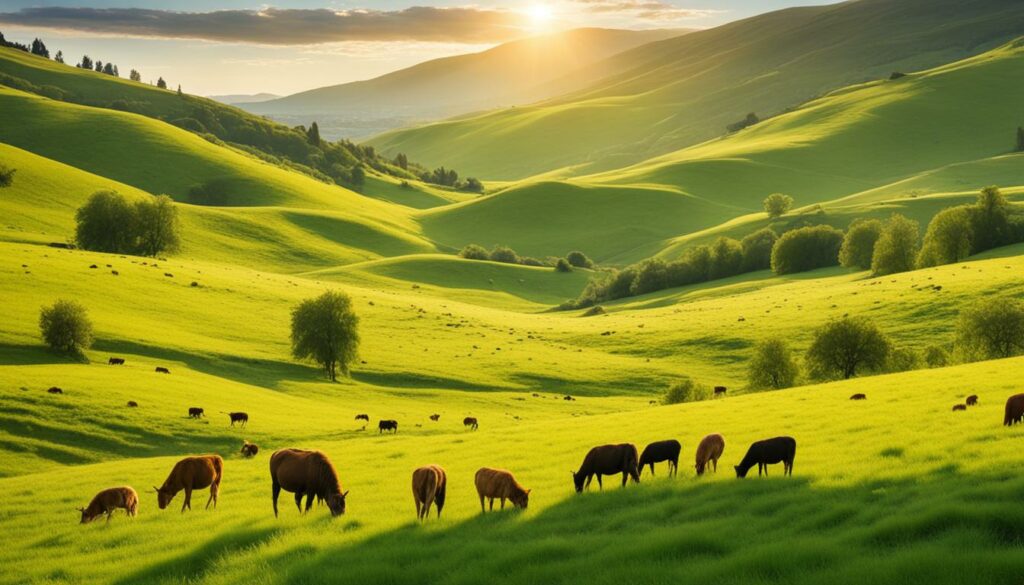
Eggs from pasture-raised hens are better, too. They have more Omega-3 and Vitamin A. Research backs up that animals free to graze are healthier. So, they need less medicine. Cows that graze a lot have healthier milk, which means fewer cow diseases.
The earth loves pasture-raised animals. Their lands are free of bad chemicals. This helps keep the local eco-system safe. Plus, no chemicals mean the air is cleaner, which is big news for our planet today. Farming this way also makes the soil and water healthier.
On the flip side, it does cost more to produce things this eco-friendly way. This is because it takes more time and effort. For example, a pastured chicken costs more than one from a big farm. Yet, people are starting to prefer these more natural choices. This shows a growing respect for our planet by choosing ethical foods.
Embracing ethical farming practices is key in organic farming. It focuses on high animal welfare and sustainable organic dairy and meat. This shows our care for animals and those who eat the food.
Ethical farming is about the five freedoms for animals. They include being free from hunger, thirst, and discomfort. Animals should also not suffer from pain and disease and not be afraid.
This approach makes life better for animals on organic farms. For instance, Organic Valley farms let animals outside all year. This improves their health and helps the environment.
Serving 100% organic feed is crucial in ethical farming. The USDA says this feed has to be natural, without GMOs. This makes sure the food from the animals is healthy for us.
Using certain types of animal breeds is also part of being ethical. Organic farms choose breeds that do well outside. These breeds help make better organic dairy and meat.
| Aspect | Ethical Farming Practices | Factory Farming Practices |
|---|---|---|
| Animal Welfare | Five freedoms of animal welfare | Confinement and limited movement |
| Feed | 100% organic, free from GMOs | Grain-fed, routine antibiotic use |
| Environmental Impact | Supports biodiversity, reduces carbon footprint | Contributes to greenhouse gas emissions |
| Health Risks | Minimised antibiotic resistance risk | Increased risk of antibiotic-resistant bacteria |
Organic farms lead by high ethical standards. This helps make healthier environments and provides top-quality, moral food to all.
Organic livestock farming is about using kind and green ways to look after animals. This ensures we use natural resources well and help our planet. The goal is to have farms that are healthier for everyone and work with nature.
Organic farming lets animals live freely and without cages. They can go outside all year, which is good for them. This way, animals are not as stressed and are healthier. It’s also a nicer way of treating them.
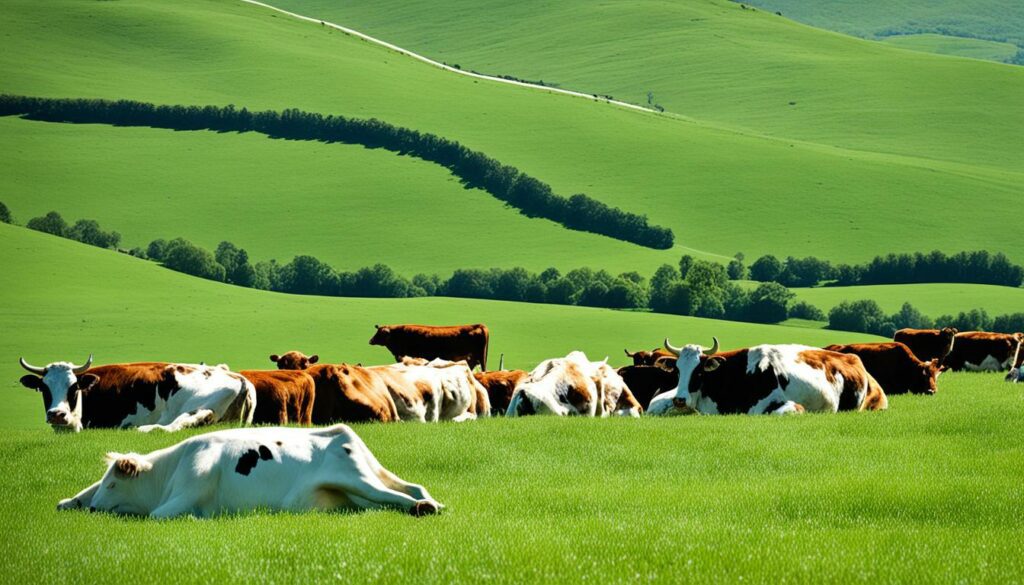
Organic animals must follow special rules on what they eat and how they’re looked after. Since they’re almost born, they must get only organic food. This includes special food, but it’s always healthy and good for the environment.
For some animals, eating grass is really important. They must get to eat fresh grass for a certain time each year. This helps keep them healthy and happy. Plus, it makes the meat or milk they give us better for us too.
Grass eating and free-living animals are key for a good, lasting farm. To keep everything in balance, organic farmers do special things for the ground and plants. This keeps the farm going strong without hurting the earth.
The market for organic meat is growing. More people want organic products that are good for the planet. They are choosing organic meat because it’s healthy and helps the environment.
The amount of land for certified organic meat in the U.S. has grown. By 2021, it reached 4.89 million acres. This is a good sign for organic farming. Grocery stores have seen a big boost in organic food sales, more than natural food shops.
The U.S. government is putting more money into researching organic food. Funding has jumped from $3 million in 2002 to $50 million in 2023. This has helped make advancements in the sustainable meat industry. More land is used for organic farming now than before.
Even though organic farmland in the U.S. is less than 1%, it contributes a lot to the country’s farming income. In 2021, organic sales, especially of fruits and veg, were about 3% of all farm earnings. Fruits and vegetables are the top-selling organic items, making up around 36% of sales.
The Corn Belt and Delta region have seen big jumps in organic sales too. The Corn Belt had nearly 8% of organic sales in 2021, up from 6% in 2012. The Delta area’s sales shot up by 3,582% to $143 million.
| Year | Certified Organic Acres (in millions) | Federal Organic Research Funding (in millions) | Percentage of Organic Food Sales by Retailers |
|---|---|---|---|
| 2000 | 1.8 | $3 | Natural Food Stores Dominant |
| 2021 | 4.89 | $50 | 55.6% by Conventional Grocery Retailers |
More people are buying directly from farms. In 2021, this method hit 12.6% of sales. This was much more than 10 years ago, when it was only about 10%. Sales through the internet also increased from 2.1% in 2012 to 6.5% in 2021.
The sustainable meat industry is getting stronger. Farms are focusing on being ethical. They have the support of people who want to know their meat is produced in a sustainable and fair way.
Hormone-free livestock means avoiding artificial growth hormones and antibiotics. This, part of organic farming, is great for the animals. They are not given things that might harm them.
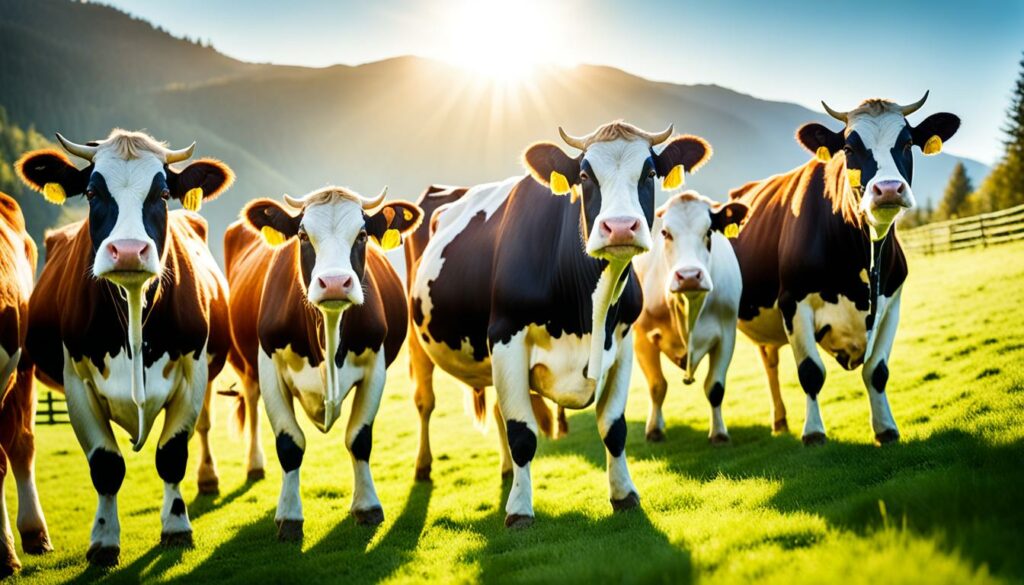
Life for animals on organic farms is much better than in regular farming. Organic rules help keep the environment healthy too. Farmers follow rules that use less water and keep wildlife safe.
Pasture-based operations make a big difference. Here, animals eat organic grass. This makes their products, like eggs and milk, healthier for us. It also means they help the earth by trapping carbon.
Breeding heritage animals is better for the planet. These animals are used to living outside. They fit well with organic farming, which is kind to the earth and animals. Factory farming, on the other hand, hurts the climate.
Organic farms don’t use antibiotics if they can help it. This means less need for the vet, which is good for the animals and the farming budget. Organic animals also eat mostly organic food, avoiding chemicals.
Here’s how factory farming and organic farming are different:
| Aspect | Factory Farming | Organic Livestock Management |
|---|---|---|
| Animal Quality of Life | Generally Lower | Significantly Higher |
| Environmental Impact | High Greenhouse Gas Emissions | Low, Carbon Sequestering |
| Use of Antibiotics | Common | None |
| Breed Suitability | Modern Breeds | Heritage Breeds |
By following organic rules and keeping livestock free from hormones, we do better for the planet and the animals. Not using antibiotics is healthier for the animals and us. Their food helps our health and the health of the earth too.
Organic animal feed is crucial for sustainable farming practices. This is because more people prefer livestock to eatorganic feed standards. These standards ban synthetic chemicals, GMOs, and harmful pesticides in animal diets. This means organic and soy-free feeds are becoming the norm for many farmers.
Organic animal feed has to meet strict rules. It boosts the health and performance of animals. Feeds made with natural ingredients help animals grow well, boost their immune system, and keep their stomachs healthy. This is true for a range of animals, from cows to goats and sheep.
Using organic animal feed also meets the growing demand for ethically produced meat and dairy. Feeds must meet tough guidelines from groups like the Northeast Organic Farming Association. This means foods like poultry are free from harmful substances and allergens.
Besides helping animals, organic feeds benefit the environment. They cut down the need for chemicals and harmful GMO crops. This choice helps protect wildlife and saves water. Buying feeds from nearby farms helps support local food supplies and connects farmers directly with consumers. This builds a stronger, community-focused way of farming.
Following organic feed standards is good for the planet in the long run. Their use helps keep soil healthy and balances nature. Although these feeds cost more, they lead to healthier animals and environment wins.
Our push for sustainable farming drives us to keep improving organic feeds. We aim to make them better and more efficient. Sticking to these strict standards means we are committed to a greener, healthier way of farming.
Organic livestock farming mixes animal care with caring for the Earth. We use strict methods to raise livestock in ways that help them live naturally and stay healthy. This approach not only looks after the animals but also helps the environment in important ways.
One key part of this farming is to save natural resources and keep diversity alive. By managing animals carefully, we reduce harm to the land and water. This helps in keeping the earth and our water clean. We use pastures that can trap harmful carbon, which is much better for the planet than other farming methods.
Keeping animals in pastures makes them healthier. They need the vet less often and cost less in medicines because they eat from these lands. Using these methods, we don’t need to give them antibiotics often. This helps lower the risk of diseases that don’t respond to medicine, which is good for everyone’s health.
Using certain animal types in this farming creates stronger animals. They’re better at living outside and are less likely to get sick. This way of doing things helps the Earth and makes products like eggs and milk better for us. They have more good fats in them, which is good for our health.
Grazing livestock on less fertile lands is a smart use of space. This way, we make the most out of our land. All the food they eat has to be produced in an organic way. This part is very important and shows how organic farming cares about everything it does.
No synthetic pesticides or GMOs are used in organic farms. This helps keep our planet’s balance and stops harm to the environment. Organic livestock farming isn’t just good for the animals. It’s also a great model for farming in a way that is good for everyone and our Earth.
Organic livestock farming uses strict organic welfare standards. These focus on what animals need and health practices. For example, cows, sheep, and goats must graze in organic pastures for 120 days. Their food must be 30% from these pastures, keeping their diet natural.
Livestock must be on organic pastures for 120 to 365 days a year, based on the area’s weather. USDA rules say they must have outside access and clean water from their last stage of pregnancy or second day of life. They need shelter and space for moving to stay healthy and happy.
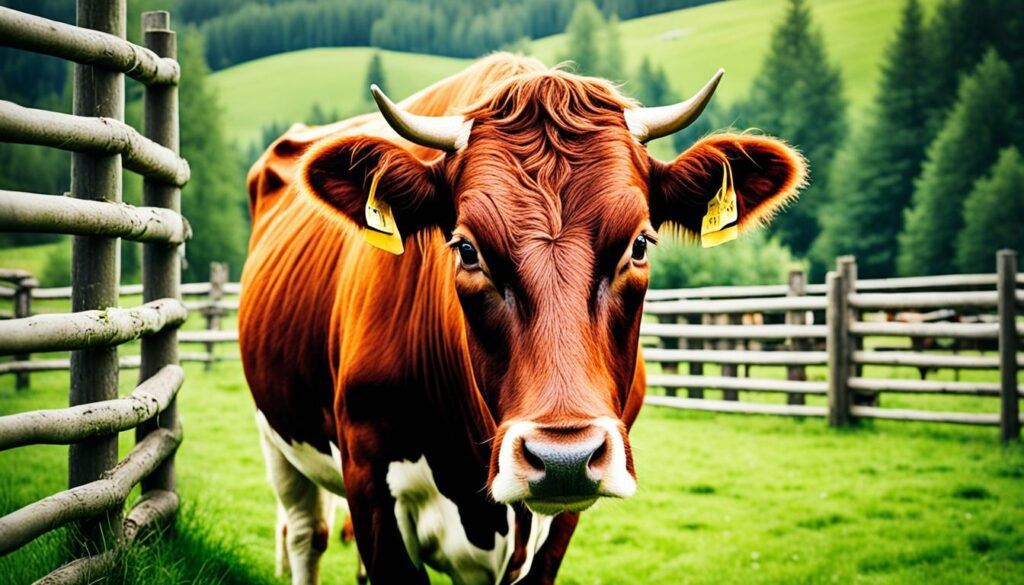
Organic farming tries to use less medicine. Choosing the right animals and how they are looked after helps stop diseases. Only some medicines, like vaccines, can be used. This method makes animals less sick, cutting costs and unwanted deaths.
The USDA’s rules protect 186 million animals in organic farming. People care more about how their food is made and are happy to pay more for good welfare. This shows that meeting high welfare standards is important not just for the animals but also for the farmers.
Organic health care focuses on the stomach and how animals are treated. This respects the animals and meets customers’ wishes for ethical farming. Organic farming values health and happiness for all animals. It’s good for the farm and the food we eat.
Organic livestock farming brings big benefits for the planet. It focuses on pesticide-free agriculture. And this has led to less greenhouse gases and a healthier environment. By using grazing lands smartly and recycling manure, the impact on the environment is positive.
Research shows that organic farming boosts the amount of carbon in soil, which is good for the Earth. Also, more than 700 studies say organic farming helps more species of plants and animals to thrive. This is important because organic farms don’t use genetic engineering (GMOs).
In Europe, countries like France and Germany are pushing for more organic farming to fight groundwater pollution. In Bhutan, every farm aims to be organic by 2020. And Sikkim, India reached this goal in 2016. This shows that going all organic is doable and good for the planet.
| Country | Organic Agriculture Initiative |
|---|---|
| Bhutan | 100% Organic Farming Goal by 2020 |
| Sikkim, India | Achieved 100% Organic Farming in 2016 |
| France & Germany | Promoting Organic Farming to Combat Groundwater Pollution |
| USA | 3% of Food Sales were Organic (2012) |
Going organic also means using less fossil fuels. This helps fight climate change by putting carbon into the soil. Still, some research from Sweden suggests that organic peas might have more emissions than non-organic. This shows that a mix of farming methods may be best. But, choosing organic food is a step towards a greener future.
Organic livestock farming faces many problems. The weather can be unpredictable, affecting when animals can graze. Also, organic rules ban the use of antibiotics. This makes natural disease prevention essential.
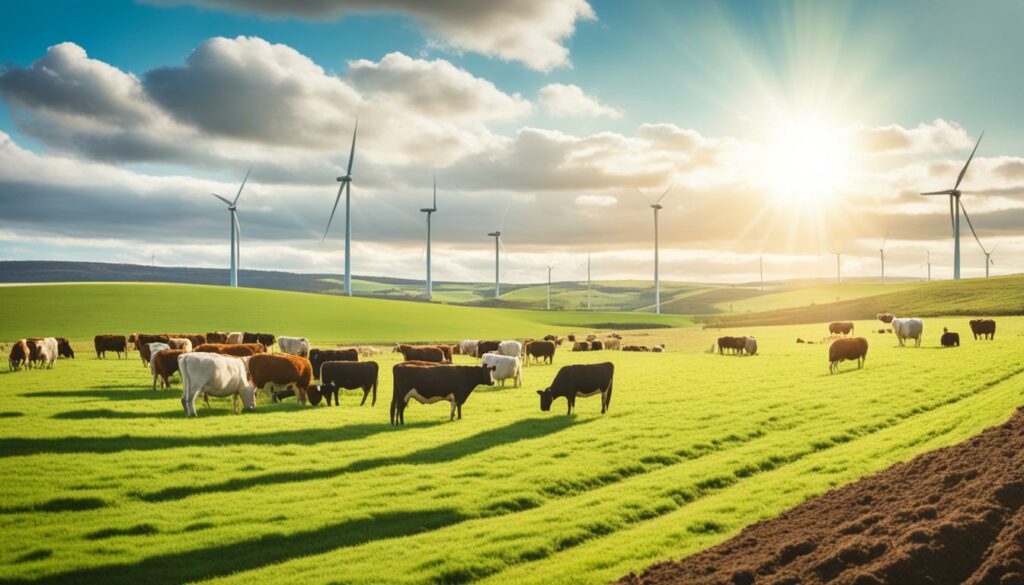
Farmers must be prepared for changing weather. They choose hardy animals and employ smart grazing to ensure there’s enough food. This helps keep the animals healthy even when the weather is bad.
Dealing with diseases naturally is a big issue for organic farms. Without antibiotics, they rely on good hygiene, proper food, and clean water. These steps help keep the animals well.
While hard, these methods create a better farm and are sustainable.
Organic livestock farming has more benefits than regular farming. It helps save the environment and supports local communities.
Livestock farms use a lot of space and contribute to greenhouse gases. But, they are key for rural development. Organic methods are important for a stable future.
Over 23% of the EU lives in the countryside. Organic animal farming helps the environment and brings jobs.
| Aspect | Conventional Farming | Organic Farming |
|---|---|---|
| Greenhouse Gas Emissions | High | Moderate |
| Antibiotic Use | Frequent | Prohibited |
| Natural Resource Conservation | Low | High |
| Economic Impact | Standard | Positive Externalities |
In tackling challenges, innovation and a drive towards sustainability are key. These efforts maintain livestock health while helping the planet. They also support local life.
For in-depth information on fighting diseases sustainably, check out this resource.
Organic and conventional farming differ on health impacts and economic points. These differences play a key role in the ongoing organic vs conventional agriculture debate.
Organic farming is known for health benefits. It avoids synthetic chemicals. These include pesticides and antibiotics usual in conventional farming.
This avoidance is a big health plus for people. It’s why many prefer organic meat and dairy. Plus, organic milk’s production impacts the planet less.
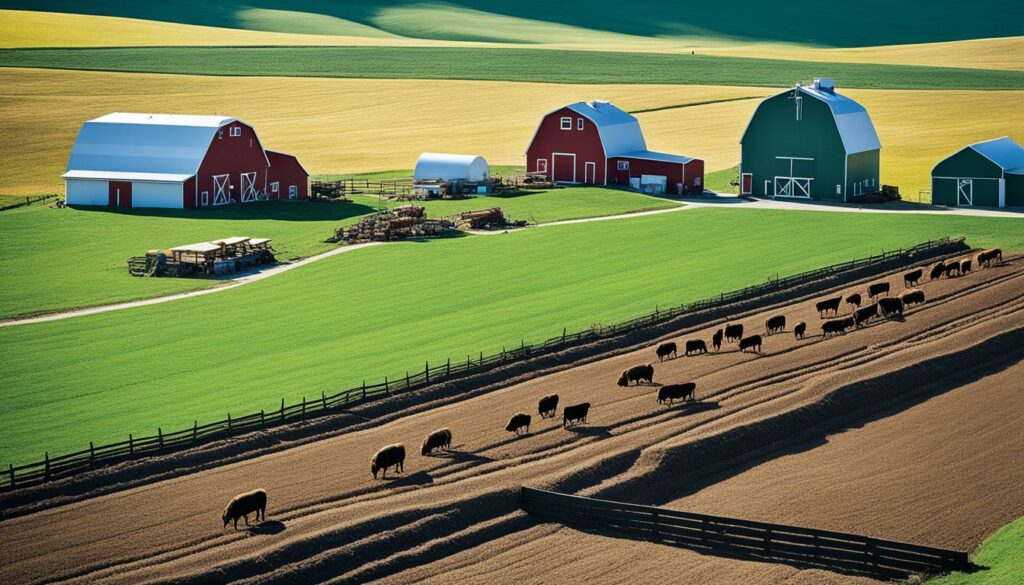
Economic sustainability is key when we compare these farming types. While organic foods cost more, they attract buyers willing to pay extra for health and ethics.
Organic farming stays strong due to demand for healthier, ethical options.
Organic foods are pricier, but organic farmers earn more per animal. This contrasts with conventional systems overall. Conventional often spends less yet might not mean higher farmer profits.
| Aspect | Organic Farming | Conventional Farming |
|---|---|---|
| Land Use | 49% more land use | Less land per unit of production |
| Global Warming Potential | 13% higher than conventional | 17% higher for milk production |
| Fossil Fuel Energy Use | Lower per unit milk | Greater fossil fuel energy use |
| Income per Animal | Higher | Lower income risk |
| Feed Conversion Ratio | Higher | Lower |
| Acidification/Eutrophication Potential | Lower per unit land | Generally lower |
Conventional farming often shows higher productivity. However, organic farming’s benefits include less harm to biodiversity and better animal welfare.
It’s clear, choosing between organic and conventional farming involves trade-offs.
Successful organic farms set the bar high for sustainable farming. Organic Valley is a great example. It shows how small family farms can thrive by following organic practices.
Organic Valley is a group of small, family-owned farms. They focus on doing farming the right way. This means they look after their animals well and care for the environment.
Factories farms in the U.S. house 99 percent of livestock, causing a lot of waste. Organic Valley, however, works to be kind to the earth.
Food Tank highlights farmers making big changes. They’re changing the world through smart farming practices. Take a look at:
Organic Valley does a lot to help small farmers. They support groups that share advice and good farming methods. This helps keep organic farming strong.
| Farmer/Farm | Country | Innovative Practice |
|---|---|---|
| Keith Mikkelson’s Aloha House | Philippines | Integrates organic farming with cattle, goats, hogs, and chickens for local food production |
| Belcampo | USA | Vertically integrated meat supply chain focusing on transparency and traceability |
| Brown’s Ranch (Gabe Brown) | USA | Employs no-till farming techniques, integrates cattle, cover crops, and cash crops |
| Chew’s Agriculture | Singapore | Joined the Certified Humane programme and invested in sustainable practices |
These organic farms show what good farming can achieve. By working together and farming smart, they succeed. They prove that organic farming is not just good for the earth but also for the people.
Looking into the future, we see how important innovation in animal husbandry becomes. It will lead progress. This is crucial for better animal care, farm efficiency, and sustainability.
Organic farming benefits greatly from new tech and research. Sustainable agriculture trends indicate a big increase in USDA funds for organic research. From $3 million in 2002, it hit $50 million in 2023. This helps develop farming that follows organic principles.
The US’s organic-certified land has been growing, hitting 4.89 million acres by 2021. This increase shows people’s belief in the benefits of organic farming. Introducing more new farming methods could push this further and boost how much we’re farming from.
Looking overseas gives us hints about the future of organic farming. The European Union’s organic area grew by 56% between 2012 and 2020. In 2020, Spain had over 2 million hectares of certified organic land. These global trends suggest ways for the US to grow its organic farming.
In conclusion, future organic farming will rely on a lot of research, new tech, and what consumers want. By following these directions, we can make sure organic livestock farming stays a good choice for both farmers and buyers.
Organic livestock farming is a key part of ethical and sustainable farming. It focuses on animal well-being, green practices, and meeting customer needs for ethical food. Livestock are raised in an organic way, with access to the outdoors all year round. They eat only organic feed.
Taking care of the land and managing pastures well is very important. We don’t use artificial fertilisers. Instead, we grow different kinds of plants to make the soil healthy. This leads to better food for our animals. Also, when we start with non-organic methods, we make sure that the livestock only gets organic feed for half a year. This ensures its quality.
Organic farming has many good effects, not just on animals but also on nature. It cuts down on greenhouse gases and avoids dangerous chemicals. This helps plant and animal life to thrive. Plus, it brings positive effects like more jobs and better incomes for farms. Even though there are challenges, like dealing with the weather and diseases, organic farming has a bright future. We will keep improving and stick to our high standards for looking after animals and the environment. This way, we can keep up with the demand for healthy and environment-friendly food.
Organic livestock farming is centred on ethical meat production. It focuses on high welfare for animals. Also, it aims at using sustainable farming methods.
It is crucial as it helps keep our planet diverse. It boosts the welfare of animals. Plus, it offers food that’s free from harmful chemicals.
The USDA’s certification means animals have space to roam and sleep in clean areas. They eat food that’s certified as organic. Inspections by experts also ensure these rules are followed.
Pasture areas are turned often for eating and avoiding soil wear. This keeps the soil and water healthy. It makes farming in harmony with nature.
Such animals have better digestion and are less sick. They live off the land, which keeps them well and happy.
These practices give animals the freedom they need. They have organic food, rooms to roam in, and places to act naturally.
They use systems that let animals move freely and eat naturally. This helps them stay healthy and happy.
People want meat that comes from caring farms. They know such meat is good for the Earth and for them.
Avoiding these keeps animals and their products pure. This approach highlights the difference between organic and standard farming.
Having organic feed means animals eat good, clean food. This is key to keeping our farm ecosystem in balance.
Organic farms help the Earth by using fewer harmful chemicals. They also use methods that protect the air and water, like rotating pastures.
They deal with changing weather and keeping animals healthy naturally. To cope, they use tougher animal breeds and care for their animals in many ways.
Organic farming is about health and the environment. It’s chosen for its natural food and caring farming methods. Also, it’s supported by people who want to buy food that’s good for the planet.
Organic Valley is known for its success. It shows how small farms can do well by farming the organic way. They care about the land, the animals, and the people around them.
Future trends will focus on new ways to look after animals and the land. More people understanding and wanting organic food will drive these changes. They’ll lead to farming that’s even better for our world.